|
February 8, 2006
Presenting: The National Gallery of Canada
- One of Ottawa's Treasures
Canada's capital has many sights to see and the National
Gallery of Canada is one of its treasures. I will have the opportunity
to visit Ottawa myself this coming weekend and in anticipation of
this excursion I have been doing a lot of research about Ottawa
and its attractions.
To find out more about the National Gallery of Canada I contacted
Katja Canini from the Gallery who was able to give me a lot of useful
background information about this Canadian institution.
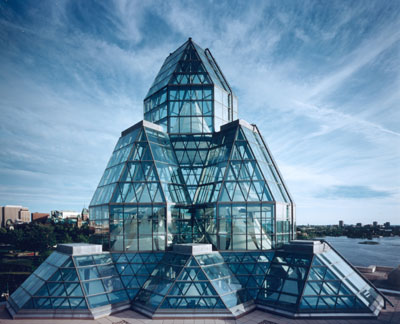
National Gallery of Canada
1. Please tell us about the history of the National Gallery
of Canada.
In 2005 the National
Gallery of Canada (NGC) celebrated the 125th Anniversary of
its founding in 1880 by the then Governor General, the Marquess
of Lorne, and the Royal Canadian Academy of Arts. With the enactment
of the 1913 National Gallery of Canada Act, the Federal Government
assumed responsibility for the fledgling institution. The Government
continued its stewardship through successive acts of parliament,
culminating in the Museums Act of July 1, 1990, which established
the Gallery as a crown Corporation and confirmed the Canadian Museum
of Contemporary Photography (CMCP) as an affiliate of the National
Gallery of Canada.
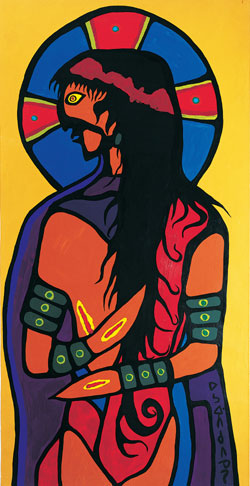
Norval Morrisseau
Indian Jesus Christ 1974
acrylic on paper
134.6 x 68.5 cm
Indian and Northern Affairs Canada, Gatineau, Quebec
© Norval Morrisseau
2. Where is it located?
The National Gallery of Canada is located in Ottawa, Ontario at
380 Sussex Drive. To get to the NGC from highway 417, take the Metcalfe
exit. Follow Metcalfe Street around the Museum of Nature and continue
northbound until you reach the end of the street at Wellington.
You will see Parliament Hill. Turn right onto Wellington Street
and continue in the left-hand lane until you reach Sussex Drive.
As you approach Sussex Drive, you will see the Chateau Laurier hotel
on your left-hand side. Make a left turn onto Sussex Drive and continue
until you see the Gallery, to your left, at the corner of St. Patrick
and Sussex. The Gallery is a large glass building with two octagonal
towers. Just beyond the St Patrick/Sussex intersection you will
see the left-turn lane to enter the Gallery's underground parking.
The National Gallery's underground parking garage; $1.50 per half-hour,
up to a maximum daily charge of $8.50. Evening rate (after Gallery
closing) $4.25. Discount for Members is $6.50
Please call (613) 990-1985 for more information, if you are outside
the National Capital region please call 1-800-319-2787 for TDD please
call (613) 990-0777.
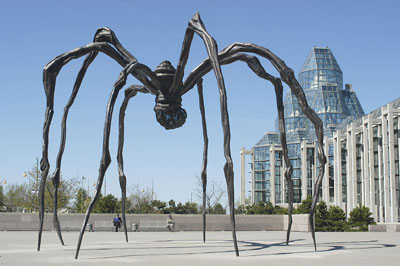
Louise Bourgeois
Maman 1999 (cast 2003)
Bronze, stainless steel, marble
927 x 891 x 1024 cm
National Gallery of Canada, Ottawa
© Louise Bourgeois
3. What are the opening hours?
The Gallery’s winter hours from October 1 - April 30 are as
follows open Wednesday to Sunday 10 am to 5 pm, Thursday to 8 pm.
From May 1 - September 30 the Gallery is open 7 days a week, Wednesdays
to Sundays from 10 am - 5pm, Thursday to 8pm. The Gallery is also
open during the Quebec and Ontario schools' Spring Break, Easter
Monday and Thanksgiving Day; it is closed on Good Friday, Christmas
Day and January 1.
4. What are the admission fees?
PERMANENT COLLECTION;
Adults $6
Seniors $5
Full-time students $5
Youths (12–19) $3
Family (2 adults, 3 youths) $12
Free for children under 12 and for Friends of the NGC
Free Thursdays after 5 pm (permanent collection only)
SPECIAL EXHIBITION
Norval Morrisseau 3 February - 30 April 2006
Adults $12
Seniors $10
Full-time students $10
Youths (12-19) $5
Family (2 adults, 3 youths) $24
Free for children under 12 and for Friends of the NGC
* Includes admission to the permanent collection.
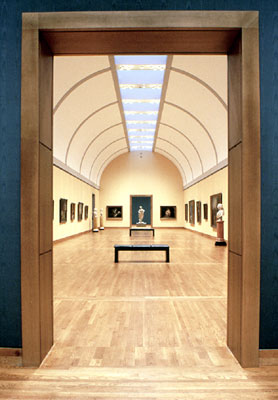
National Gallery of Canada
SAVE!
Keep your Norval Morrisseau admission ticket and get $2 off you
ticket to the Sunil Gupta and Imprints exhibitions at the Canadian
Museum of Contemporary Photography, until 23 April 2006. Some restrictions
may apply.
AUDIOGUIDES
Bell audioguides highlight many works of art from the permanent
collection in English, French, Spanish, German, and Mandarin ($3).
Available in the Great Hall.
ADVANCE TICKET SALES
Except where noted, you may obtain tickets or register for programs
either in person or by calling (613) 998-8888 or 1-888-541-8888
(service charges apply on purchases by phone). All prices include
taxes.
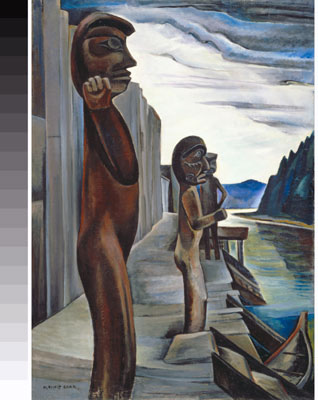
Emily Carr
Blunden Harbour c. 1930
oil on canvas, 129.8 x 93.6 cm
National Gallery of Canada, Ottawa
Purchased 1937
Photo © National Gallery of Canada
5. Please tell us more about the building that the National
Gallery is located in.
Created as a permanent home for the institution in 1988, the building
was conceived by internationally renowned architect Moshe Safdie,
the Gallery’s design echoes the near Library of Parliament,
and mirrors the soaring spaces of Notre-Dame Basilica opposite.
At it’s heart lies a unique treasure: the reconstructed nineteenth-century
Rideau Street Convent Chapel. The Great Hall the Gallery’s
principal ceremonial space, was designed as a tribute to the Parliamentary
Library, itself a Victorian reinterpretation of a polygonal Gothic
chapter house.
The Taiga Garden located next to the Amphitheatre makes a symbolic
reference to Canada’s northern climate and typically rugged
terrain. Conceived by the landscape architect Cornelia Hahn Oberlander,
the garden design was inspired by the slabs of rock into which the
Gallery was built.
Inside the Gallery, water and garden courtyards provide peaceful
spaces, inviting visitors to pause and reflect.
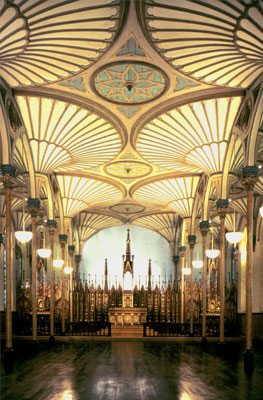
National Gallery of Canada, Rideau Street Convent Chapel
6. What is the National Gallery's mission?
The strength of the National Gallery of Canada lies in its collection
of art, especially Canadian art, and its accessibility to the public
across the country. The collection opens the way for appreciation
of the finest in artistic expression, with works of art that reveal
the past, celebrate the present, and probe the future. The collection
must be expanded, preserved, interpreted and used to the utmost
by the public for pleasure and understanding, for research and the
advancement of knowledge.
The mandate of the National gallery, as set out in the 1990 Museums
Act is: to develop, maintain and make known, throughout Canada and
internationally, a national collection of works of art, historic
and contemporary, with special but not exclusive reference to Canada;
and to further knowledge, understanding and enjoyment of art in
general among all Canadians.
The National Gallery of Canada strives to provide Canadians with
a sense of identity and pride in Canada’s rich visual arts
heritage and to make art accessible, meaningful and vital to diverse
audiences of all ages.
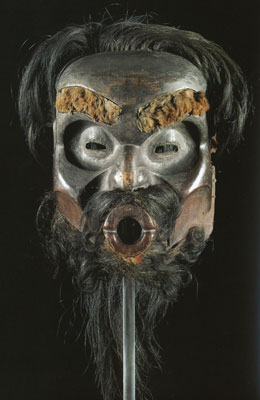
Kwakwaka’wakw Artist
Mask 19th century
Cedar (?), hair, fur, pigment
The British Museum, London
7. Please tell us about the collections featured at the
National Gallery.
The National Gallery of Canada’s collection of Canadian art
including Inuit Art, assembled since 1880, is the most comprehensive
and important in existence. The Gallery also has a fine collection
of Western European art dating from the late Middle Ages to the
present, including prestigious collections of important prints,
drawings and photographs. The international works help place Canadian
art in its broader context by demonstrating the influences on and
evolution of the visual arts in Canada.
The Gallery’s collection consists of over 37,000 works of
art, acquired either by purchase or as gifts. About 1,200 to 1,500
of the most significant of these works – over 20% of its paintings
and sculptures – are on view over the course of the year in
the Permanent Collection galleries. Works in the Gallery’s
Prints, Drawings and Photographs collections are featured in a program
of rotating exhibitions, and about 3,000 square feet of Gallery
space is dedicated to the display of contemporary Canadian art.
The CMCP collection holds over 161,000 images by contemporary Canadian
photographers, of which 144,000 are negatives or transparencies
and 17,000 are prints. Works in the CMCP collection are also featured
in a program of rotating exhibitions.

National Gallery (right), Canadian Parliament Buildings (left)
8. What types of programs and activities do you offer?
Education is a critical aspect of the Gallery’s mandate, and
a key priority for the Gallery and the CMCP. The Gallery offers
a wide range of educational and public programs to schools, families,
youth, adults and seniors, and to people with disabilities.
CyberMuse,
the Gallery’s on-line educational tool, features the works
and artists represented in the permanent collection and is targeted
to children, youth and teachers. It offers information on and insight
into the world of artists and their work, through images, audio
and video presentations, and a growing number of artist interviews
and biographies.
Current event information can be found at www.gallery.ca
by following the link to Programs and Activities.
9. Please tell us about the exhibitions that are currently
on view at the Gallery.
The current special exhibition Norval Morrisseau - Shaman Artist
is on display from 3 February to 30 April 2006.
Norval Morrisseau’ s sublimely colourful and deeply spiritual
works have inspired three generations of First Nations artists and
made him an icon of Canadian art.
Norval Morrisseau, also called Copper Thunderbird, rose to fame
in the 1960s as the originator of the Woodland School. This unique
style is now simply called Anishnaabe painting, a term that refers
to the artist’s heritage and the archetypal status of his
work.
This exhibition features 60 vibrant works, from evocations of ancient
symbolic etchings on sacred birchbark scrolls and pictographic renderings
of spiritual creatures, to more recent works that are celebrations
of pure colour. Morrisseau reveals something of the soul of humanity
through colour and his unique “X-ray” style of imaging:
Sinewy black “spirit” lines emanate, surround, and link
animal and human figures, and skeletal elements and internal organs
are visible within their brightly coloured segments.
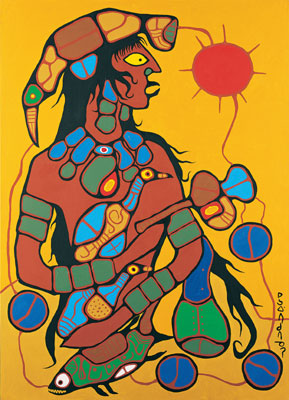
Norval Morrisseau
Man Changing into Thunderbird
(panel 1 of 6) 1977
acrylic on canvas
153.5 x 125.7 cm
Private collection
© Norval Morrisseau
10. What exhibitions are coming up? What type of exhibitions
have you held in the past?
Upcoming exhibitions include Emily Carr: New Perspectives (2 June
– 4 September 2006), Edwin Holgate (6 October 2006 –
January 2007), Clarence Gagnon, 1881-1942: Dreaming the Landscape
(6 October 2006 – January 2007), and Renoir Landscapes (8
June – 9 September 2007).
Past exhibitions have included Christopher Pratt; Leonardo Davinci,
Michelangelo and the Renaissance in Florence; The Group of Seven
in Western Canada; the Age of Watteau, Chardin, and Fragonard.
11. Please comment on traveling exhibitions that make the
National Gallery accessible to people outside of Ottawa as well.
The Gallery’s Traveling Exhibitions Program is the largest
of any art museum in North America, and reaches a broad range of
institutions, including those in small and remote communities, as
well as audiences abroad. More information on what is near you can
be found at http://www.gallery.ca/ in the exhibitions, traveling
exhibitions page.
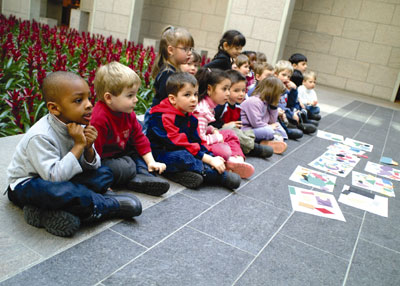
National Gallery of Canada
12. Please tell us about the types of activities and tours
available at the National Gallery for adults and children. You also
host concerts.
A range of activities are available for children aged 3 and up,
teens, adults, and seniors. Our popular After Hours program for
adults, thematically linked to our special exhibition, is an opportunity
for adults to enjoy an evening of fine art, music and a special
menu served to compliment the theme of the evening.
Children’s programming is extensive and includes Esso Family
Fundays, Saturday Morning Art Club, Tiny Tots for children aged
3 – 5, March Break and Summer Camps, Birthday Workshops, and
Artissimo activities are free with admission and are available on
weekends and during holidays for children 3 and up.
Unique programs for children, teens and adults occur in conjunction
with special exhibitions please visit www.gallery.ca
for up to date program and registration information.
Guided Tours of the National Gallery’s Permanent Collection
are offered at 2 pm from Wednesday to Sunday from 1 October to 30
April, and daily at 2 pm from May through September and are free
with gallery admission.
You can now enjoy a personal tour of the Gallery's famed Canadian
collection with our easy-to-use audioguide. This lively recording
allows visitors to access over 200 commentaries about the Canadian
galleries and individual works in the collection. The audio tour
is narrated by radio personalities Karen Flanagan-McCarthy and Steve
Madely, and accompanied by music from Canadian recordings. Audioguides
for the Canadian collection are available in English, French, Spanish,
German and Mandarin. At the Information Desk in the Great Hall.
Cost: $3.
Guided Tours for Groups of the Permanent Collection are $6 per person
plus admission to the permanent collection with a minimum of 10
and maximum of 25 persons per guide.
Rates for guided group tours of the special exhibitions vary according
to each exhibition on view. Minimum of 15 persons per group. Admission
dates, times, and prices are subject to change. Please call (613)
990-4888, TDD (613) 990-8340, to confirm details prior to arrival.
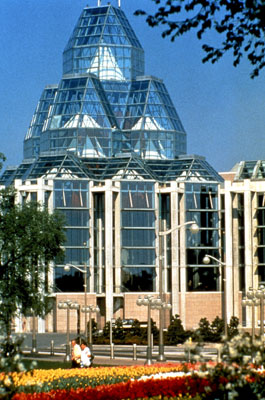
National Gallery of Canada
13. Please tell us about the Research Resources that are
available at the National Gallery.
Research Resources include the NGC Library and Archives, the Research
Fellowship Program, and the provenance research project. The Library
is open to the public at select times and it’s catalogue can
be searched online at http://bibcat.gallery.ca/screens/opacmenu.html.
14. Please tell us about your visitor facilities, shopping
opportunities and food services.
Strollers and wheelchairs provided free of charge at the Foyer Information
Desk. Audioguides for the permanent collection are available (cost
$3) at the information desk in the Great Hall.
Visitors may take pictures for personal use, with a hand-held camera
and electronic flash, of works in the permanent collection. It is
not permitted to reproduce or sell the photographs, to photograph
works on loan, in temporary exhibitions or in the Canadian and Aboriginal
Art galleries, or to use a tripod
The Gallery Bookstore sells a variety of fine jewelry, gifts, exhibition
merchandise and of course books. A range of foodservice areas are
available to Gallery visitors, each offering an interesting and
unique variety. Managed by KW Catering and Events, they offer moderately
priced food and are licensed to serve beer and wine.
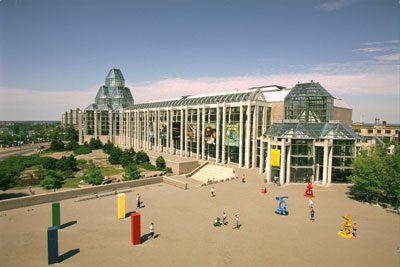
National Gallery of Canada
15. What special events are coming up for 2006 at the National
Gallery?
The NGC will feature the work of Emily Carr in the summer of 2006.
Best known for her paintings of First Nations villages and landscapes
of the northwest Pacific coast, Emily Carr (1871-1945) is the subject
of numerous biographies, scholarly articles, documentary films,
plays, a musical, an opera, and poetry. Regarded as a writer, environmentalist,
feminist icon of Canadian art, defiant Victorian, solitary eccentric,
and documenter of Northwest Coast monumental art, she has endured,
nevertheless, as a larger-than-life enigma.
The show Emily Carr: New Perspectives (2 June – 4 September
2006) looks at Carr through the historical lens of 20th century
exhibitions that presented her work, and in the social and political
contexts that defined her world. What emerges is a compelling new
portrait of this much-loved artist.
Featured are some 200 objects – paintings, drawings, watercolours,
caricatures, ceramics, sculpture, hooked rugs, books, maps, photographs,
and ephemera – including about 150 works of art by Carr –
on loan from the National Gallery, the Vancouver Art Gallery, and
major institutions across the country.
Thank you, Katja, for this great overview of the National Gallery.
Related articles:
A general overview of things to see
and do in Ottawa
Presenting: The ByWard Market
- One of Ottawa's hottest entertainment areas
Helpful websites:
Tourism
Ottawa: Ottawa's official tourism information
The ByWard
Market Business Improvement Area
The
National Capital Commission
The National
Museum of Civilization
The National Gallery
of Canada
Useful books about Ottawa:
|